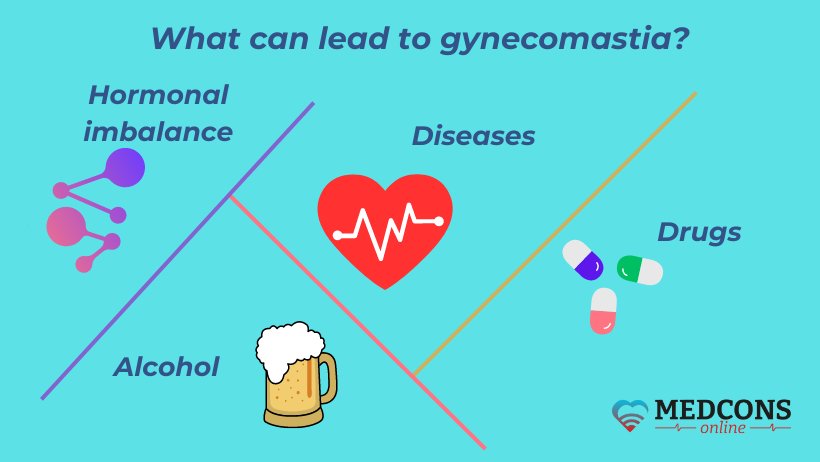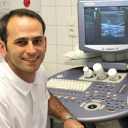
Fat deposits in the breast area are often found in severely overweight men. But, in addition to this, breast enlargement can indicate serious disorders in the male body. The condition is called gynecomastia. In the case of tissue overgrowth, it is important to see an experienced doctor to determine the exact cause of gynecomastia, and to select an effective treatment based on it.
General information
Gynecomastia is a male breast condition. It is manifested by one or two-sided enlargement of the breasts due to hypertrophy of fat or glandular tissue. It is accompanied by gland thickening, its increase in size, a feeling of heaviness and pain. In some cases, the condition can regress by itself. In other cases, drug therapy is prescribed, or, should it be ineffective, a surgical procedure. Gynecomastia should not be neglected since it increases the risk of developing breast cancer.
The size of the breast affected by gynecomastia can vary greatly. The most common is an increase of up to 4 cm in diameter. At the same time, one should visit a doctor even with 2 cm in diameter. The abnormal condition results in aesthetic and physical discomfort.
Classification of gynecomastia
Gynecomastia can be false and true. The latter is characterized by excess of glandular tissue, while pseudogynecomastia is characterized by an accumulation of fatty tissue, which is observed in overweight and obesity.
True gynecomastia can be physiological, occurring at certain periods of development, and abnormal, resulting from specific health conditions.
Physiological gynecomastia types include:
- Newborn: almost 70-85% of newborn children have enlarged mammary gland tissue. The main reason is the effect of maternal female sex hormones on the fetus during fetal development. After 3-4 weeks, the signs go away on their own.
- Puberty period: breast enlargement is observed in 40-55% of teenagers, more often on both sides. Its cause is endocrine system failure in boys. Within 1-2 years, all symptoms pass on their own.
- Older age: the disorder is detected in men aged 60-80 years. It happens due to a decrease in testosterone levels associated with age-related changes.
Symptoms
Newborn babies have lumpy and slightly enlarged breasts, and sometimes there is a discharge of colostrum from the nipple. In adolescents and adult men, breasts may increase significantly. In some cases, the diameter of the breast reaches 15 cm with a mass of 160 g. At the same time, the areola and the nipple grow in size, and pigmentation becomes more pronounced. In men, nipple discharge is rare. In most cases, there is no pain, but there may be discomfort when the clothes touch the nipple, since it becomes too sensitive.
Unilateral gynecomastia in men is less common. It is associated with an increased risk of malignant transformation, which can be attributed to the fact that gland growth is caused by hormonal changes. Typical complaints include pain and a feeling of pressure. With an increase in prolactin levels, erectile dysfunction and nervous system disorders are added.
The development of gynecomastia has certain stages:
- developing, which lasts for 4 months and can regress;
- intermediate, with formation of glandular tissue, lasting up to one year;
- fibrous, which is characterized by the formation of fat and connective tissue, regression without treatment is not possible.
Pathogenesis
Mail mammary glands are normally underdeveloped. They have a small amount of glandular and fatty tissue, ducts and nipples. The gland development depends on the level of female hormones. Normally men have a small amount of estrogens, but they are quickly broken down under the influence of androgens.
If the balance between androgens and estrogens is broken with an increase in female hormones, the sensitivity of tissues to testosterone decreases. The body starts to develop according to the female type with a pronounced production of glandular tissue.
The causes of true gynecomastia can include:
- Hormonal disorders. The primary cause may include tumors of the testicles, lungs, stomach, adrenal glands, pituitary gland, pancreas. The disease can also develop in patients with adenoma of the prostate and inflammatory processes in the testicles.
- Elevated levels of prolactin in the blood associated with pituitary tumors or hypothyroidism.
- Metabolic disorders, including diabetes, obesity and toxic goiter.
- Heart disease, herpes, HIV, chest trauma, cirrhosis.
- Prolonged use of medications that can affect the condition of the breasts. These are corticosteroids, gonadotropin blockers, and drugs that increase estrogen production.
- Drug abuse (marijuana, heroin use) and alcoholism.

Gynecomastia diagnosis
It is important to accurately determine the prime cause. Results can be achieved only if it is treated properly. The patient examination is carried out according to the following plan.
Medical history and risk factors
During the interview, the doctor determines how long ago the breasts began to enlarge; what the symptoms are, and what factors may have provoked the abnormal process. The purpose of questioning is to find out chronic diseases, past history of injuries and current medications.
External Examination
The examination evaluates the degree of breast enlargement, its state, structure, uniformity, and painful areas. If only one breast is affected, the second one should necessarily be examined as well.
Ultrasound examination of the breast
It is the most accessible and safe method of diagnosis. Of course, ultrasound can detect lumps and nodules, but it does not give complete information.
Ultrasound findings alone are not enough to make treatment decisions. This method is unable to identify the type of abnormal condition.
Mammography
The study is recommended only if cancer is suspected due to specific signs, provided that the patient is more than 50 years old. The reason is that the probability of malignant tumors is only 1% and occurs only in patients of the older age group.
Hormone screening
Hormone tests are mandatory. They are aimed at determining the levels of testosterone, estradiol, prolactin, TSH, and luteinizing hormone.
Magnetic resonance imaging
If elevated prolactin levels are detected, an MRI of the pituitary gland is indicated. Patients in this group often have nipple discharge. Elevated estradiol levels are an indication for MRI or ultrasound of the adrenal glands and testicles.
Biopsy followed by histological examination
The procedure is indicated when there is an evident growth of the mammary glands and a high risk of cancer. The presence of blood-stained nipple discharge can also be considered an indication for tissue biopsy.
Gynecomastia treatment
One should see a doctor whenever signs of gynecomastia appear. For newborns, regular visits to the pediatrician and surgeon are sufficient, since the condition often heals on its own. In other cases, more active doctor involvement is required.
Does gynecomastia disappear on its own?
Sometimes the breasts can return to normal size again within a few months. This is especially possible if the gynecomastia is mild or pubertal. However, if the enlargement persists for more than a year, it can be assumed that it will not go away without surgery.
In some cases, patients who are bothered by the appearance of enlarged breasts try to reduce them through sports and targeted training of the pectoral muscles. In the case of lipomastia, this may indeed result in an improved appearance. However, experience has shown that these measures have no effect on glandular overgrowth.
Which doctor should you consult for gynecomastia?
If you notice breast lumps or gland enlargement, you should visit a surgeon. The best choice is a specialist who has already had experience working with such conditions. It is recommended to choose a large clinic with a well-equipped operating room and a license to perform plastic surgery, as not only the removal of the gland, but also liposuction with subsequent skin tightening may become necessary during the procedure.
Gynecomastia drug therapy
In the initial stages, drug therapy is possible. These can include estrogen blockers, which give the opportunity to stop the growth of glandular tissue. The option is appropriate if the cause of gynecomastia is a hormonal failure or a long course of medications.
Surgery
If the condition persists for a long time and is unlikely to regress, surgery is considered. The strategy in this case will depend on the stage of the disease.
- At stages 1 and 2, therapy includes removal of glandular tissue with simultaneous restoration of an anatomically correct shape. It is especially important to consider the wishes of clients regarding the future results. In some cases, a small amount of fatty tissue is left to create a more rounded shape of the breast. It is important not to let the areola and nipple fall through. It is also necessary to properly plan the position of the sutures, so that the scars will be seen. If you are overweight, liposuction is performed at the same time.
- At stages 3-4, a breast lift is indicated in addition to removal of glandular tissue, since the excess volume leads to skin stretching. Liposuction is also possible. To achieve an aesthetically pleasing result, the suture is placed along the edge of the areola. At stage 4, free amputation of the breast with subsequent areola transplantation is possible.
Treatment of gynecomastia in adolescents
In adolescents, in most cases, gynecomastia regresses on its own without any treatment. Regular monitoring with hormone level tests is enough.
Non-drug therapy for gynecomastia. Folk remedies
There are a large number of recipes aimed at reducing fatty tissue in the breast area and normalizing hormone levels. Still, patients should clearly understand that no folk remedy can guarantee results.
Long-time use of phytohormones can cause serious disorders, while gynecomastia will continue to progress until surgery becomes necessary.
Gynecomastia outcomes, prognosis and complications
Gynecomastia as such does not present a life threat. However, the diseases that cause abnormal breast enlargement can be extremely dangerous. Possible consequences include:
- Slouching, which occurs as a defensive reaction. The patient tries to hide the aesthetic defect so that it is not noticed by others. Gradually, this leads to the curvature of the spine and the resulting consequences.
- Frustration. Breast growth in gynecomastia can have a negative impact on self-esteem. There are complexes, dissatisfaction with one’s own body. Affected persons avoid going to swimming pools, beaches, public places, where it is necessary to expose the torso, or refuse to go to the clinic for the examination of the respiratory system. All this imposes a large number of restrictions on the patient, increasing the risks associated with untreated diseases.
- Breast cancer. The probability of developing cancer is only 1%, but if the cause of breast enlargement is hormonal disorders, the risks increase by 10 times. Therefore, men with gynecomastia should immediately consult a surgeon and be examined for cancer.
As for gynecomastia prevention and prognosis, everything depends on the age at which the condition occurred, and how it was treated. In adolescents with the first signs of gynecomastia, a nutritious diet and favorable conditions for the formation of motivation to practice sports are important. Regular physical activity and a sufficient number of vitamins and minerals in the body will help to sustain the normal hormone levels. At high risk of obesity and secondary gynecomastia, diet and exercise are indicated. Adult men should refrain from using anabolic hormones during training if possible.
In general, gynecomastia preventive measures boil down to proper nutrition, regular exercise and the timely treatment of diseases that can adversely affect the hormone levels.
Second opinion
A second opinion is a possibility to get medical advice from doctors at European clinics. The disease in question is rather an uncommon one. Physicians who have not previously encountered gynecomastia may not be aware of new approaches in the diagnosis and therapy of the disease. An additional consultation with doctors who specialize in this particular area will help you learn more about the disease and its treatment options.
You can refer to European experts at any stage:
- At first signs of the disease, one should visit a doctor. However, one should not be in a hurry to do an MRI, biopsy and so on. Causes can vary, and very often even the first symptoms can hint at the right path. A doctor's consultation will help to make a plan of examination on the basis of the existing symptoms.
- If tests have already been carried out, European experts will help to interpret the results, read the MRI scans and help to accurately determine the diagnosis.
- When drawing up a therapy plan, it is especially important to find the right solution. This can be either drug therapy or surgery. Experienced specialists have their own tried-and-true tactics to help the patient achieve a positive result from the therapy.
- After surgical treatment is also important to continue monitoring and, sometimes, treatment. That is why expert advice is important also during the rehabilitation phase.
References
- E. Kauf: Gynäkomastie im Kindesalter. In: Fortschritte der Medizin. 1. Dezember 1998, Band 116, S. 23–26, PMID 10023187
- Swerdloff RS, Ng JCM. Gynecomastia: Etiology, Diagnosis, and Treatment. [Updated 2023 Jan 6]. In: Feingold KR, Anawalt B, Blackman MR, et al., editors. Endotext [Internet]. South Dartmouth (MA): MDText.com, Inc.; 2000-. Available from: https://www.ncbi.nlm.nih.gov/books/NBK279105/
- Sreekar Harinatha. The Male Breast: What You Should Know about Gynecomastia. Notion Press (July 6, 2020). ISBN-10:1648508499, ISBN-13: 978-1648508493


Comments — 0